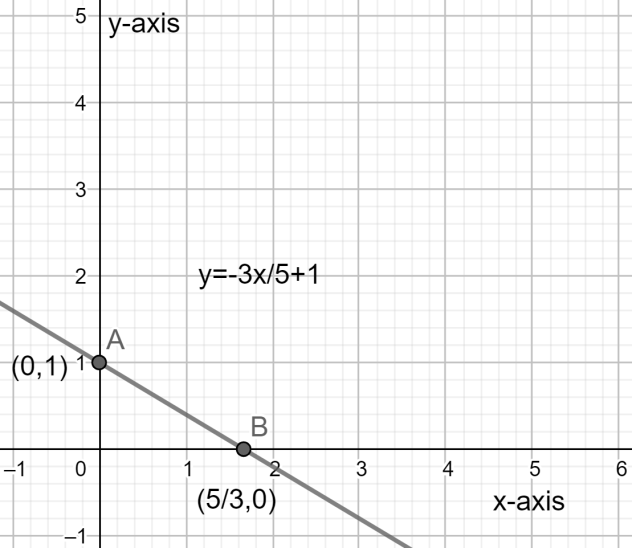
How do you graph $y=-\dfrac{3}{5}x+1$ ?
Answer
539.7k+ views
Hint: For answering this question we need to draw the graph of $y=-\dfrac{3}{5}x+1$ . For drawing the graph of the straight line we will find the intercepts of the given equation of the straight line and plot them and join them and extend the line formed. The intercepts are the respective points when the other variable is zero.
Complete step-by-step solution:
Now considering from the question we have to draw the graph of $y=-\dfrac{3}{5}x+1$ .
From the basics of the concept we know that for drawing the graph of the straight line we need to find the intercepts of the given equation of the straight line and plot them and join them and extend the line formed.
The intercepts are the respective points when the other variable is zero.
The $\text{x-intercept}$ is given by substituting $y=0$ in the given equation of the straight line.
After substituting we will have
$\begin{align}
& \Rightarrow 0=-\dfrac{3}{5}x+1 \\
& \Rightarrow -1=-\dfrac{3}{5}x \\
& \Rightarrow x=\dfrac{5}{3} \\
\end{align}$
The $\text{y-intercept}$ is given by substituting $x=0$ in the given equation of the straight line.
After substituting we will have
$\begin{align}
& \Rightarrow y=-\dfrac{3}{5}\left( 0 \right)+1 \\
& \Rightarrow y=1 \\
\end{align}$
So now we have two points lying on the straight line $\left( 0,1 \right)$ and $\left( \dfrac{5}{3},0 \right)$ .
Now we will plot these two points and join them and extend them to form a straight line. The graph of the straight line is shown below.

Note: For answering this question we need to draw the graph of the given equation of the straight line so we need to be careful while plotting the points and extending the line. We should be careful while performing the calculations. The slope of this given straight line \[y=-\dfrac{3}{5}x+1\] is $\dfrac{-3}{5}$ as we know that the slope intercept form is given as $y=mx+c$ where $m$ is the slope.
Complete step-by-step solution:
Now considering from the question we have to draw the graph of $y=-\dfrac{3}{5}x+1$ .
From the basics of the concept we know that for drawing the graph of the straight line we need to find the intercepts of the given equation of the straight line and plot them and join them and extend the line formed.
The intercepts are the respective points when the other variable is zero.
The $\text{x-intercept}$ is given by substituting $y=0$ in the given equation of the straight line.
After substituting we will have
$\begin{align}
& \Rightarrow 0=-\dfrac{3}{5}x+1 \\
& \Rightarrow -1=-\dfrac{3}{5}x \\
& \Rightarrow x=\dfrac{5}{3} \\
\end{align}$
The $\text{y-intercept}$ is given by substituting $x=0$ in the given equation of the straight line.
After substituting we will have
$\begin{align}
& \Rightarrow y=-\dfrac{3}{5}\left( 0 \right)+1 \\
& \Rightarrow y=1 \\
\end{align}$
So now we have two points lying on the straight line $\left( 0,1 \right)$ and $\left( \dfrac{5}{3},0 \right)$ .
Now we will plot these two points and join them and extend them to form a straight line. The graph of the straight line is shown below.

Note: For answering this question we need to draw the graph of the given equation of the straight line so we need to be careful while plotting the points and extending the line. We should be careful while performing the calculations. The slope of this given straight line \[y=-\dfrac{3}{5}x+1\] is $\dfrac{-3}{5}$ as we know that the slope intercept form is given as $y=mx+c$ where $m$ is the slope.
Recently Updated Pages
Why are manures considered better than fertilizers class 11 biology CBSE

Find the coordinates of the midpoint of the line segment class 11 maths CBSE

Distinguish between static friction limiting friction class 11 physics CBSE

The Chairman of the constituent Assembly was A Jawaharlal class 11 social science CBSE

The first National Commission on Labour NCL submitted class 11 social science CBSE

Number of all subshell of n + l 7 is A 4 B 5 C 6 D class 11 chemistry CBSE

Trending doubts
What is meant by exothermic and endothermic reactions class 11 chemistry CBSE

10 examples of friction in our daily life

One Metric ton is equal to kg A 10000 B 1000 C 100 class 11 physics CBSE

1 Quintal is equal to a 110 kg b 10 kg c 100kg d 1000 class 11 physics CBSE

Difference Between Prokaryotic Cells and Eukaryotic Cells

What are Quantum numbers Explain the quantum number class 11 chemistry CBSE




